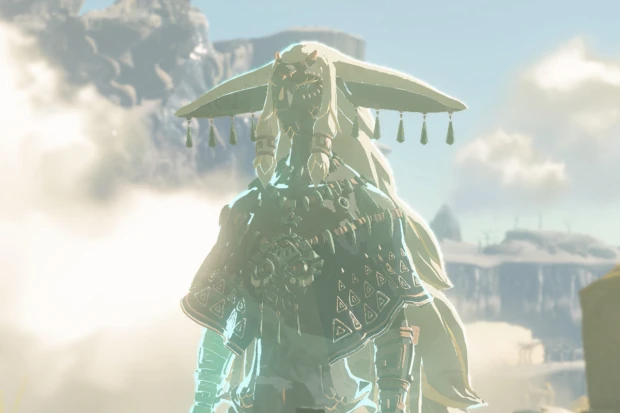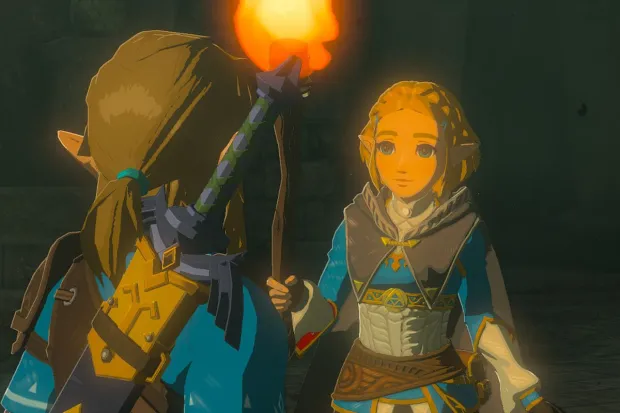by Jed Pressgrove
And then I woke up.
– Ed Tom Bell (played by Tommy Lee Jones), in the film No Country For Old Men.
Tears of the Kingdom led me back to a feeling I had in 2017 with Breath of the Wild: an absence of heart. Not having heart is the ultimate game killer. “No más,” said pugilist Roberto Durán to the referee in 1980, ruining one of boxing’s most anticipated rematches. I understand Durán when I ponder how my time with Zelda has ended two games in a row. The phrase has nothing to do with inability — Durán had notched one win against his opponent, Sugar Ray Leonard, and wasn’t losing by much in the rematch — and everything to do with a lack of investment.
Tears of the Kingdom is not unlike many modern big-budget video games: mechanics upon mechanics, curios upon curios, waypoints upon waypoints. All the crap you pick up is not actually crap, yet nothing feels essential. Outside of a few idiosyncratic enemies and a curiously placed shrine, I don’t admire anything I have discovered.
A game like this should have exciting action. Nevermind that Tears of the Kingdom reuses many thrills from its predecessor — the monster killing is mundane and emotionally vapid compared to that of several titles indebted to the Zelda series (e.g., Shadow of the Colossus, Dark Souls, and Hyper Light Drifter). Link might have early god-like potential (most shrines are a cinch with Ultrahand and Recall), but the proposition of breaking the game is not anymore interesting than it was in Scribblenauts or Hack N’ Slash.
After a period of amusement using the new powers, a sense of pointlessness emerged as I realized I was traversing a world with a consistent stream of moderate intrigue, nipping at an ever-dangling carrot. The caves and the sky islands are merely extra content, distractions from the reused setting and the awful story. In this collection of locations, there are no high points or low points, just a bunch of mid points. Nintendo straps you to a bed and plugs 10 IVs into your veins. You’re always getting injected, always feeding, but you’re never satisfied or healed, like a junky with no god and a patient with no timetable for discharge. Almost every experience amounts to a nice plateau, so when one has a rare sensation that registers between an above-average thrill and a very good rush, one might feel wowed.
The world of Zelda is purgatory made ultra consumable.
In Desert Golfing, I am on hole 1401, 3653 strokes. In front of my ball is a sand shed with a sharply angled roof. Then the land flattens and stretches a little more than halfway across the screen before revealing the hole. On the other side of the hole is the steep edge of a fat hill.
I now look at hole 1402, which sits on top of the fat hill. Exasperatingly, the hole resides on the edge of a ridge. There’s no space to the left of the hole for the ball to sit, meaning the ball will roll down back toward the tee if it doesn’t land in the hole, and to the right of the hole, the ball has little room to travel before it would fall off the other side of the hill into a moderately shallow crevice. Past this crevice the ball would go off-screen, triggering a restart.
I would prefer not to deal with 1402, but it’s against the rules to see any new part of the desert before putting the ball in the hole.
This far into the game, I’m more fascinated by what the next section of land will look like than I am by how many strokes I will use on a hole. After all, I’ve hit hundreds of hole-in-ones at this point.
I’m well over a 1,000 holes in and have only seen water about 10 times. I have seen one rock. I used about 30 strokes hitting my ball into the rock, pushing it yard by yard until it fell into the hole first.
Desert Golfing isn’t open like Tears of the Kingdom, but it has a more curious and delightful exploratory philosophy. There’s an invitation to see Desert Golfing’s world, one screen at a time, this eternal sand trap, this place of triangles and other geometric shapes, this landscape of slopes, recesses, 90-degree walls, and clusterfuck canyons, this setting of meditation and self-determined pars and everlasting training, this neverending stretch of orange, this magnificent ode to random generation that resembles a natural progression of geological erosion.
I appreciate and anticipate every part of Desert Golfing’s setting. Spoiled, I take the environmental offerings of Tears of the Kingdom as a given.
I wish Tears of the Kingdom would overwhelm me, plunge me into doubt and hopelessness, confound me. Progress seems predestined despite the ridiculous number of variables at play. Death in Tears of the Kingdom is irrelevant. I die and return to a nearby checkpoint, perhaps with more hearts than when I crossed the same spot. Every navigational challenge is no more than a temporary annoyance. The answer to everything is immediately apparent. I always know I’m capable of advancing. So what’s the point of moving forward?
Tears of the Kingdom specializes in deliberate predictability. Like Breath of the Wild, it sees itself as a survival test. But I consider myself foolish, not resilient, for engaging with the game’s dull and awkward routines. I have come to despise every jump, every instance of climbing or gliding, every swing of a weapon, every time I have to access a power or an item from a menu. I know why people dedicate themselves to Ultrahand wizardry: Without that novelty, Tears of the Kingdom is monotonously superfluous.
I knew something was dead wrong after I joined forces with bird boy Tulin. Tulin is an amateurish gimmick. He’s positioned as an essential part of the greater mission, but his status as a CPU-controlled juvenile gives off the odor of God of War trendiness. His wind gust ability epitomizes tortured design: To activate this underwhelming technique, Tulin must be close enough to Link to summon the almighty on-screen button prompt. It actually requires two button presses for Tulin to unleash his special move. The utter inelegance of the controls and the one-note personality of the sidekick speak to Nintendo’s low creative standards, which doom what should have been an enlivening ascent into the sky.
The idiocy of this scenario — naturally, Nintendo has the gall to label Tulin and other helpers as Sages — inspired me to take a break from the main story and wander about. After hours of the isomorphic caverns, dime-a-dozen enemy encampments, uninteresting wildlife, and silly side quests, I said to myself: NO MORE!
To see consumerism as a kind of longing for spiritual connection in a world that has less and less space for the sacred, the mysterious, the luminous, opens up the idea of what we do in the games industry as more than straightforward game material. We touch on much deeper longings, fantasies, and desires. We sell dreams.
– narrative designer Meghna Jayanth.
Transforming into a horse that crushes monsters with its hind legs represents a more interesting fantasy than the Ultrahand prospect of constructing a flying car, mecha, or giant rotating flamethrower. I’ve used countless vehicles and contraptions in games, but I had never assumed the role of a violent stallion, a deranged mermaid, or a toxic slug until I played Nobody Saves the World.
Unlike Link, the titular protagonist of Nobody Saves the World is void of distinguished features. The eye sockets of this freak are empty. He is pallid and scrawny. He slaps his hand at opponents like a child. He is a joke, a winking reference to the modest saviors of countless fantasy games.
But he can shape-shift into other beings and wield their most lethal tactics and attacks. As in Tears of the Kingdom, your initial efforts with all the abilities involve minor growing pains. Nobody receives experience points by killing enemies in particular ways and doing other things, like opening chests. (You’re reading that right. You get rewarded for finding rewards.)
Nobody Saves the World and Tears of the Kingdom appear quite different. Their systems, structures, and capabilities don’t bear much similarity. Neither do their audiovisual styles or storytelling approaches.
Yet their ideologies match perfectly. They romanticize and fetishize the lone hero. One who saps the resources around him like a ferocious anteater, demolishes habitats as if justified by divine right, and rubs shoulders with glorious destiny. These heroes are successful in the most self-righteous, circular manner possible. Their dominance receives comprehensive, immutable backing by thematic suggestions about lowly beginnings, working one’s way up, and earning the respect of people. Contra pushes machismo. Hades worships rebellion. Zelda and Nobody present phony holiness as a sacred goal.
Beyond all my misgivings about the mechanical, kinetic, and environmental limitations of Tears of the Kingdom and Nobody Saves the World, I am most tired of their veiled and deceptive ego-building effect which leaves me hollow and aimless, notwithstanding the digital riches they can grant to me. In our slumber as gamers, kingdoms are forever customized for our fleeting happiness.


